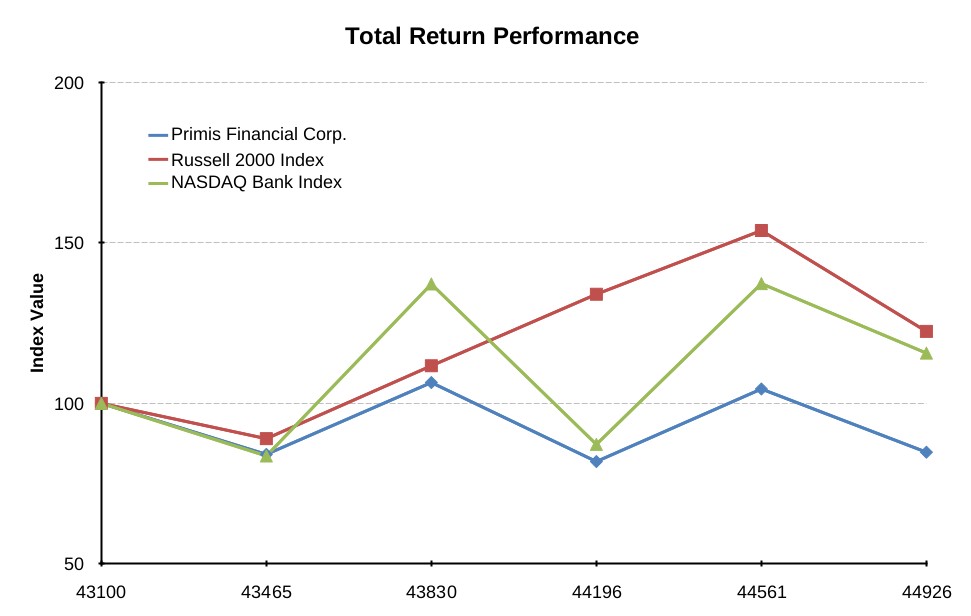termination of insurance on deposits, the issuance of removal and prohibition orders against institution-affiliated parties, and the enforcement of such actions through injunctions or restraining orders. The exercise of this regulatory discretion and power may have a negative impact on us.
As a regulated entity, Primis and the Bank must maintain certain required levels of regulatory capital that may limit our operations and potential growth.
As further described above under Supervision and Regulation—Capital Requirements, Primis and the Bank each are subject to various regulatory capital requirements administered by the FRB.
Failure to meet minimum capital requirements can initiate certain mandatory, and possibly additional, discretionary actions by regulators that, if undertaken, could have a direct material effect on the Bank’s and our consolidated financial statements. Under capital adequacy guidelines and the regulatory framework for prompt corrective action, the Bank must meet specific capital guidelines that involve quantitative measures of the Bank’s assets, liabilities and certain off-balance sheet commitments as calculated under these regulations.
As of December 31, 2022, Primis and the Bank exceeded the amounts required to be well capitalized with respect to all four required capital ratios. As of December 31, 2021, Primis’ leverage, CET1 risk-based capital, Tier 1 risk-based capital and Total risk-based capital ratios were 9.68%, 10.30%, 10.63%, and 14.57%, respectively. As of December 31, 2022, the Bank’s leverage, CET1 risk-based capital, Tier 1 risk-based capital and Total risk-based capital ratios were 11.39%, 12.64%, 12.64% and 13.84%, respectively.
Many factors affect the calculation of Primis and the Bank’s risk-based assets and its ability to maintain the level of capital required to achieve acceptable capital ratios. For example, changes in risk weightings of assets relative to capital and other factors may combine to increase the amount of risk-weighted assets in the Tier 1 risk-based capital ratio and the Total risk-based capital ratio. Any increases in its risk-weighted assets will require a corresponding increase in its capital to maintain the applicable ratios. In addition, recognized loan losses in excess of amounts reserved for such losses, loan impairments, impairment losses on investment securities and other factors will decrease the Bank’s capital, thereby reducing the level of the applicable ratios.
Primis and the Bank’s failure to remain well capitalized for bank regulatory purposes could affect customer confidence, our ability to grow, our costs of funds and FDIC insurance costs, our ability to pay dividends on our capital stock, our ability to make acquisitions, and on our business, results of operations and financial condition. Under FRB rules, if the Bank ceases to be a well-capitalized institution for bank regulatory purposes, the interest rates that it pays on deposits and its ability to accept, renew or rollover brokered deposits may be restricted. As of December 31, 2022, we had $100.0 million of brokered certificates of deposits.
Financial Reporting Risks
Failure to maintain an effective system of disclosure controls and procedures could have a material adverse effect on our business, results of operations and financial condition and could impact the price of our common stock.
Failure to maintain an effective internal control environment could result in us not being able to accurately report our financial results, prevent or detect fraud, or provide timely and reliable financial information pursuant to our reporting obligations, which could have a material adverse effect on our business, financial condition, and results of operations. Further, it could cause our investors to lose confidence in the financial information we report, which could affect the trading price of our common stock.
Management regularly reviews and updates our disclosure controls and procedures, including our internal control over financial reporting. Any system of controls, however well designed and operated, is based in part on certain assumptions and can provide only reasonable, not absolute, assurances that the objectives of the system are met. Any failure or circumvention of our controls and procedures or failure to comply with regulations related to controls and procedures could have a material adverse effect on our business, results of operations and financial condition.
